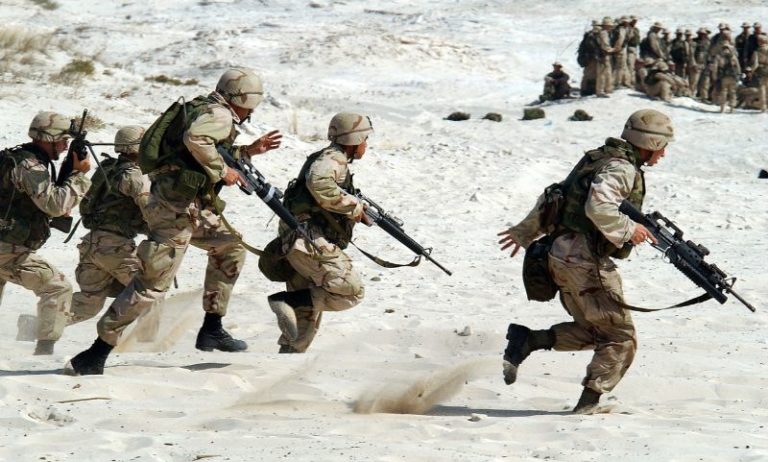Sharp, Metal-Laden Iraqi Dust May Cause Respiratory Ailments: Study

CCK Law: Our Vital Role in Veterans Law
Operation Iraqi Freedom (OIF) and Operation Enduring Freedom (OEF) are classified under the umbrella term “Global War on Terror.” This international military campaign was launched following the September 11, 2001 terrorist attacks against the United States. OIF took place from March 2003 to August 2010, while OEF began in October 2001 and continues to the present day in Afghanistan. Servicemembers returning from Iraq specifically have reported respiratory symptoms. Research is being conducted to determine if certain factors present during service in Iraq are related to the onset of respiratory-related conditions in servicemembers and veterans.
Overview of the Study
In March 2014, the Journal of Occupational and Environmental Medicine published a study examining the role of dust encountered in Iraq on the production of respiratory disease observed in some of the troops deployed there. War-related lung injuries have emerged as previously-underrecognized health problems. Health care professionals did not understand the nature of the illnesses in the beginning of the Wars in Iraq and Afghanistan. Now, new-onset lung problems have been increasingly recognized as being related to deployment in these two countries. Investigators have identified asthmatic symptoms or pulmonary function test abnormalities within this population of servicemembers and veterans.
A U.S. Army Millennium Study determined that 14 percent of veterans deployed to Iraq had new-onset respiratory symptoms, including dyspnea, exercise-induced shortness of breath, coughing, wheezing, and chest tightness. Six percent of this population presented with airway obstruction symptoms versus 8 percent presenting with other lung diseases. Of the six percent, half of those individuals experienced reversible airway obstruction while the other half experienced non-reversible airway obstruction.
This study hypothesized that ground surface dust may be a contributing factor to Iraq Afghanistan War Lung Injury (IAW-LI). Specifically, the study was designed to determine if Iraq dust has properties to yield particulate matter pollution and if inhaled Iraq dust leads to immunosuppression (i.e. suppression of the immune system and its ability to fight infections and other diseases). While the researchers focused on the impact of Iraq dust containing sharp particles less than five microns in size, they also acknowledged various other plausible causes of IAW-LI, including:
- Minerals
- Metals
- Microbes made airborne during sandstorms
- Burn pit fumes from open air burning of trash with jet fuel
- Outdoor and indoor aeroallergens
- Debris from improvised explosive devices
How the Study Was Conducted
A dust sample was collected from Camp Victory, Iraq by the United States Army Corps of Engineers for the purposes of this study. The Iraq dust was analyzed by electron microscopy for particulate size, shape, and metal constituents. Several mice were exposed to the dust through induced inhalation. The results were compared amongst those of mice exposed to other control soil samples and untreated control mice. Specifically, the results were evaluated to determine whether inhaled Iraq dust in mice leads to lung injury via immunosuppression.
Results of the Study
Results indicated the Iraq dust sample contained particles less than five microns in size. These particles are angular in shape with sharp edges; however, they are not hollow. Instead, trace metals including, but not limited to, titanium, iron, silicon, and calcium, are all present in Iraq dust. Overall, the study yielded two significant findings. First, Iraq dust-exposed mice had the most lung injury, based on a scoring system utilizing (1) the presence of crystals, (2) septate thickening, and (3) airway inflammation. The total score added the presence of all three characteristics. Iraq dust-exposed mice had the highest mean score of 5.3 versus 3.0 for non-exposed mice. Second, respirable Iraq dust leads to lung inflammation in mice similar to that seen in human patients. Both findings support the theory that respiratory-related conditions due to immunosuppression are presenting as the result of exposure to environmental factors in Iraq and Afghanistan.
Conclusions
This study confirmed that the physical properties of Iraq dust are concerning as it now shows that the dust is respirable and that the particles exhibit sharp edges and contain trace metals. Furthermore, inhalation of Iraq dust yields airway inflammation and other negative health outcomes. While military personnel may have been exposed to countless airborne hazards during deployment to Iraq and Afghanistan, this study allowed the isolation of dust and the ability to examine its components and their effect on lung health. This research provided some insight into the role of dust encountered in the Iraq and Afghanistan Wars on the production of respiratory-related conditions observed in some of the service members and veterans who served there. However, more research is needed to fully understand the role of other airborne contaminants in producing these health effects.
About the Author
Share this Post
